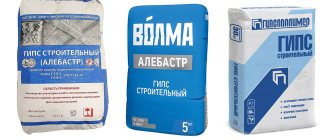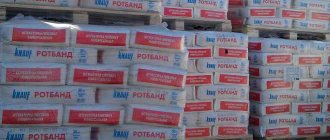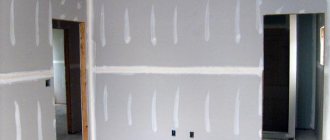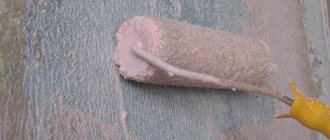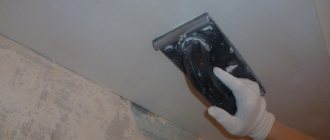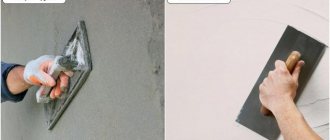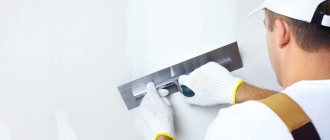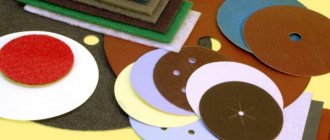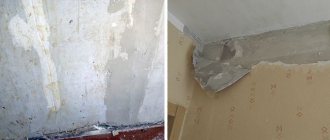Package
Regulated by GOST 9980.3-2014. It happens:
Dear readers! To solve your problem right now, get a free consultation
— contact the lawyer on duty in the online chat on the right or call: +7 (499) 938 6124 — Moscow and region.
+7 (812) 425 6761 — St. Petersburg and region. 8 (800) 350 8362 - Other regions of the Russian Federation You will not need to waste your time and nerves
- an experienced lawyer will solve all your problems!
- metal;
- glass;
- cardboard, paper;
- polymer.
The choice of packaging depends on the intended content. The materials must not react; the container or bag ensures the safety and tightness of the contents.
The standard provides specific requirements for packaged material. For example, with a weight of 400 g the deviation cannot be more than 5%. Powders - 1.5% in soft containers, 3% in other containers.
Can I use it after it has expired?
The use of such building materials is strictly not recommended. Even under ideal storage conditions, after opening the mixtures lose their original properties, and the result of the repair may be disappointing. Therefore, you should not wait until the expired contents of an open package are finished.
Important! Suitable materials must be used. Only they are guaranteed to perform their intended function and preserve the result of the repair for a long time.
Unusable plaster dries too quickly, it is difficult to distribute it evenly over the surface, this significantly complicates the work process. The situation is similar with putty.
The primer mixture also loses its anti-corrosion protective properties, which should be present for 3 years.
Storage
There is only one way to qualitatively extend the service life - proper storage.
ADVICE! If proper maintenance is ensured, the compositions will retain their original characteristics for the period guaranteed by the manufacturer.
Recommendations for diluting expired plaster and putty with acids are untenable, since their chemical composition and properties will definitely be changed.
How to do it right
It is better to store it away from crowded places, since the powder will inevitably be present in the inhaled air.
You also need to provide:
- normal humidity;
- room temperature;
- distance from heating devices, direct sun;
- functioning ventilation;
- tightly closed package.
If the mixture is already ready for use, then the packaging must be sealed after each use.
Should be stored away from sunlight and radiators.
How can you not?
You should not store it in an unheated garage or balcony, especially when it comes to ready-made mixtures, in open areas where sunlight constantly hits. Excessive humidity is destructive, so the warehouse must be heated and ventilated.
Vetonit LR+. Vetonit LR+ Plus 25kg.
Finishing putty on a polymer binder for walls and ceilings inside dry rooms.
Walls and ceilings inside dry rooms. Suitable substrates: all smooth mineral surfaces; surfaces leveled with Vetonit L, V, TT, TT Light putty or Perlite putty; gypsum surfaces; walls and ceilings made of plasterboard slabs (however, not for sealing the seams of plasterboard slabs). Ceilings made from other boards, such as particleboard or porous fiberboard, can also be sprayed.
Putty work
After preparing the surface, you can proceed directly to puttying work.
Dry cement putty is prepared as follows:
- Pour a small amount of water into a plastic container.
- Pour dry putty into the water.
- Mix the mass with any convenient object (you can use a spatula).
- Now beat the mixture with a mixer or drill with a special attachment.
- Check the consistency of the putty with a spatula - if it does not flow from it, but sticks, and feels elastic to the touch, it means it has been prepared correctly.
- If the mixture turns out to be liquid, add a little dry putty. If lumps have formed in the putty, dilute it with water.
Starting putty of surfaces:
- At the first stage, work is carried out with starting putty. After mixing, the composition will not dry out for 1-2 hours - that is how much time you have to use it. If the surface to be treated is voluminous, do not dilute a large amount of solution at once.
- Write down the proportion in which you dilute the putty so that the consistency of the next portion is the same as the first.
- If you plan to apply more than one coat of putty, you will need a special paint mesh. With its use, the surface will be more durable and smooth. The mesh can be coarser or less. The rougher it is, the smoother the surface is.
- The putty is applied diagonally with a large spatula, which is smoothed at an angle of 30 degrees. The next layer is applied as if overlapping the previous one. This is done to prevent bumps and bumps from appearing.
- If you still have traces from the spatula, don’t worry, they will definitely be hidden with finishing putty.
- The corners are puttied using a corner spatula. The putty mass is applied to the joints with a regular spatula, then smoothed with an angular spatula.
- It will take about a day for the starting putty to dry completely.
Finishing putty of surfaces:
- The next stage after the starting putty has completely dried is the finishing putty. Work is also carried out using metal spatulas. The finishing putty is applied more carefully to ensure a smooth surface.
- After puttying, the surface is checked with a level. If necessary, apply additional leveling.
- If you plan to apply two layers of finishing putty, be sure to wait until the first layer has completely dried. This will take about 12 hours.
- It is recommended to prime the surface before reapplying the finishing putty.
- After the putty has completely dried, it can be cleaned using a metal float or sandpaper in a circular motion.
- After work, all tools can be easily washed with running cold water.
- The cleaned surface can be painted, wallpapered or any other decorative work can be carried out.
Important: until the putty surface has dried, it must be protected from moisture. This especially applies to outdoor work. In case of unexpected precipitation, the surface must be covered with film.
Expired mixtures - how do they behave?
In the summer I bought 5 bags of plytonite S. I didn’t have time to do the tiles and I’m going to do it in a week. but today I read on the packaging that the shelf life of plitonite is 6 months. batch dated 05/26/05. so what to do then. buy another one?? again at 400 rubles per bag??
01/19/2006 at 01:15
This is the Gost standard for storing cement in kraft bags without loss of brand strength. The thing is very fragile and in your conditions has no practical significance.
01/19/2006 at 01:31
put it boldly and don’t think about any nonsense.
01/19/2006 at 02:45
According to my observations, expired cement mixtures, 1) after they are used for their original purpose, have lower strength than non-expired ones 2) they harden longer. So, if strength is not critical, you can use it.
01/19/2006 at 22:25
I will be laying tiles in the bathroom. So, is strength critical?
01/19/2006 at 22:34
I once plastered a wall with cement Plitonite T1+, which was about to expire; after a month, a centimeter layer was easily removed with a spatula. Durability - like shortbread. I couldn’t dry it out - I sprayed it as expected. Now I try to always buy fresh mixtures with a reserve, because... I have now seen in what conditions they are stored at the market: as a rule, it is a metal container standing on the street.
01/19/2006 at 22:41
make a test sample. try to rip it off in a week. an autopsy will show.
06/30/2008 at 22:32 07/01/2008 at 00:23
I think that if there are few bags, it is better not to risk it, but if there are a wagonload of them. I would try to contact .
07/01/2008 at 00:33
berserk wrote: A friend said that it is strictly forbidden to use expired materials - they say they will not stick to the surface, they will harden quickly, cracks will appear, etc.
If the mixture is rubbish, then so be it, and from the first minute it leaves the factory. If it’s normal, use it for at least ten years. Iskitim cement, for example, from twelve years ago is now much stronger than “fresh” cement.
07/01/2008 at 00:59
I had a case with a “rotband”. It really grabbed at the moment like alabaster. However, before that it was stored on the balcony.
07/01/2008 at 01:00
Mals wrote: If it's normal, use it for at least ten years. Iskitim cement, for example, from twelve years ago is now much stronger than “fresh” cement.
It should be taken into account that when stored, even in closed warehouses, the activity of cement, especially finely ground cement, gradually decreases, as it absorbs moisture and carbon dioxide from the air. As experiments have shown, ordinary cement under normal storage conditions after 1 month. loses 8 - 15% of its activity after 3 months. loses strength up to 20% after 6 months. - up to 30%, after a year - up to 40%. Thus, after just half a year of storage, cement grades from M600 to M400 turn into M200 and lower.
A fugen and a rotband were brought to the site. We looked at the dates - they were two (!) years overdue. They were stored all this time either in a garage or in open warehouses - free-flowing, the consistency does not raise any questions, the appearance is absolutely normal. Divorced. Gets up firmly in less than ten minutes. This is just tough! For testing, dilute it thinner - 15 minutes and the “brick” is ready. In 10 minutes you can manage to smear a certain amount, and it even sticks to the wall, but there are not just any guarantees of quality - there’s nothing to talk about at all
Timing and types
Let us analyze the periods of operation of various finishing mixtures.
Plaster
There are many types, each of which has a slightly different composition and special properties: heat or sound insulating. Regardless of the purpose of use, the shelf life is approximately the same.
| Type of plaster | Shelf life (years) | |
| Dry | Ready (factory packaging) | |
| Regular | 0,5 | 2 |
| Thermal insulation | 0,5 | 2 |
| Acoustic | 0,5 | 2 |
| Waterproofing | 0,5 | 2 |
| Decorative | 0,5 | 2 |
| Plaster | 0,5 | 2 |
| Cement | 0,5 | 2 |
putty
An intermediate layer between plaster and the finishing coating of walls or car surfaces. The time of its permissible use is similar.
| Type of putty | Shelf life (years) | |
| Dry | Ready (factory packaging) | |
| Plaster | 0,5 | 2 |
| Cement | 0,5 | 2 |
| Polymer | 0,5 | 2 |
| Adhesive | 0,5 | 2 |
| Oily | 0,5 | 2 |
| For walls | 0,5 | 2 |
| Automotive | 0,5 | 2 |
Primer
Primer treatment is important for high-quality construction and repair work, including machinery.
The manufacturer independently determines the period of acceptable use, usually 18–24 months.
There are several types of primers according to their intended purpose:
- Deep penetration is good for old houses, porous walls, putty coating. The components included in the composition protect against fungus.
- Antifungal is used to protect the walls of rooms with high humidity and insufficient ventilation. Protects against mold and mildew.
- Universal suitable for processing any surface.
- Insulating is used for external surfaces, seams, and gives durability to the treated areas.
- Adhesive provides excellent surface protection, fills pores and microcracks in concrete, enhances structural strength and contact with the coating.
According to the composition they are distinguished:
- Acrylic. Made from resins of the same name with the addition of components that promote hardening and uniform application of the solution. They do not have an unpleasant odor, so they can be used indoors.
- Alkyds are used for surfaces that do not absorb moisture well. The composition contains an organic solvent.
- Mineral ones are resistant to ultraviolet radiation and perform well on alkaline bases. Suitable for processing porous light mineral materials.
- PVA. A popular way to use PVA glue is that it forms a waterproof film. However, it also has a number of negative properties: over time it begins to peel off and turn yellow.
How long can ready-made putty be stored?
The storage time for putty produced in finished form is usually indicated in the product specifications. GOST 10277-90 defines the warranty shelf life of putty for all brands as 6 months from the date of manufacture. Manufacturers indicate large values for this parameter.
Known finished products have a shelf life of:
- Polymer Sheetrock - 12 months.
- Oil "Universal" - 24 months.
- Russian acrylic VGT - 24 months.
The period specified in the instructions for the finished plaster corresponds to keeping the packaging of the material intact and the presence of the specified climatic storage conditions. These conditions also differ for different types of goods. The Sheetrock mixture should be stored in a container with a tightly closed lid in a ventilated place, and the Universal paste should be stored at T ≤ +5 ° C in a tightly closed container without exposure to heat, moisture and sun.
The latex mixture must be stored at T ≥ 0°C. An important nuance of the product is the effect of T<0 °C on it. This property of the product does not affect the quality of the layer applied to the surface of the walls or ceiling. But during storage or transportation, the material is vulnerable to sub-zero climatic conditions. And when buying latex paste, you need to check the date of manufacture of the material to prevent it from falling into frosty conditions.
Marking
Applied in accordance with the requirements of GOST 9980.4 “Paint and varnish materials. Marking". It must be present on each unit of the lot.
| Intelligence | Example |
| Manufacturer | Russia JSC Lakokraska |
| Material | Primer |
| Net weight | 37 kg |
| Gross weight | 45 kg |
| Number of units per batch | |
| Batch number | № 3 |
| Date of manufacture | 07.12 |
| Designation of the standard or specification | GOST 24595-81 |
| Purpose, application | To prepare surfaces for finishing work. Use strictly as directed |
| Rules for storage and disposal | Store away from sunlight at room temperature |
| Best before date | 18 months from date of manufacture |
In addition, the marking contains special signs that indicate the conditions of storage and transportation of the goods.
How to understand that putty, plaster, or primer have deteriorated
Putty and plaster have similar signs of deterioration, depending on the consistency: dry or ready-mixed.
The dry mixture needs to be diluted to understand what characteristics it has. If it dries too quickly, rolls, clumps, or is not distributed evenly, we can confidently say that it is overdue. The same signs apply to ready-made formulations.
An expired primer can be identified by external signs:
- separation into factions occurred;
- a precipitate has formed;
- lumps and compactions appeared;
- there is an unusual swamp smell;
- consistency too thick.
Using old formulations
You can use putty only for leveling, and it is important to remember that the composition is gypsum, which means it is afraid of moisture. To avoid cracking or peeling of the finish, mix a small amount of the material and try applying it to the wall. You can lie down easily and straight, you can work.
Another very important point is the lifetime of the solution. With expired trains, everything is usually fleeting. That is, just a minute ago the mixture lay evenly, but now there is a stone in the bucket that cannot be picked up with a spatula. The weight and composition cannot be corrected with water, throw it away. Work with this mixture. Oddly enough, it is possible. But you should knead a little at a time in order to have time to develop the composition.
